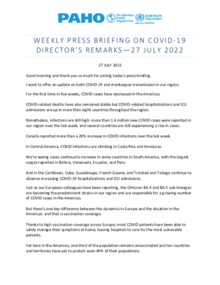Weekly Press Briefing on COVID-19: Director's Opening Remarks, July 27, 2022

|
Good morning and thank you so much for joining today’s press briefing. I want to offer an update on both COVID-19 and monkeypox transmission in our region. For the first time in five weeks, COVID cases have decreased in the Americas. COVID-related deaths have also remained stable but COVID-related hospitalizations and ICU admissions are up in more than eight countries throughout the region. Nonetheless, infections are still high: more than 1.6 million new COVID cases were reported in our region over the last week, and several countries are still experiencing a rise in cases. Canada reported more than a 20% increase in COVID infections over the last week. In Central America, COVID infections are climbing in Costa Rica and Honduras. We’re seeing cases continue to increase in some countries in South America, with the largest surges reported in Bolivia, Venezuela, Ecuador, and Peru. And in the Caribbean, Cuba, Guadeloupe, French Guiana, and Trinidad and Tobago continue to observe increasing COVID-19 hospitalizations and ICU admissions. Just as our European colleagues have been reporting, the Omicron BA.4 and BA.5 sub-lineages are becoming the predominant strains in our region and are responsible for a growing number of COVID cases in the Americas. But there’s one key difference between the dynamics in Europe and the situation in the Americas: and that is vaccination coverage. Thanks to high vaccination coverage across Europe, most COVID patients have been able to safely manage their symptoms at home, leaving hospitals to care for the most vulnerable patients. Yet here in the Americas, one third of the population remains unvaccinated and ten countries and territories have yet to protect even 40% of their populations. Our region must take Omicron seriously and consider adjusting public health measures as needed. Because these strains are more transmissible than the original SARS-CoV-2 strain, social distancing and mask wearing are still effective means to limit COVID’s spread. Countries – especially those with lagging vaccination coverage – should brace themselves and ensure their hospitals are adequately prepared to care for an influx of COVID patients. Without adequate vaccination, we leave ourselves and our families vulnerable to this evolving virus. Of course, COVID is not the only disease outbreak we are tracking, so I also want to update you on monkeypox, which was declared a public health emergency of international concern by the World Health Organization last weekend. Nearly 5,300 monkeypox cases have been reported across 18 countries and territories in the Americas, the majority being in the United States, Canada and Brazil. To date, no deaths from monkeypox have been reported in our region. Nearly all cases continue to be reported among men who have sex with men between the ages of 25 and 45 years. However, we should be clear that anyone – regardless of their gender or sexual orientation – can get monkeypox. The pattern of transmission offers a unique opportunity for countries to work closely with affected communities to ensure people know how to protect themselves and what to do if they exhibit symptoms. Unfortunately, early reports are showing that there is a lot of confusion surrounding monkeypox – that’s why clear communication is more important than ever before. PAHO is presenting daily updates to our Member States and has issued guidance for health workers to manage monkeypox cases and prevent further infections. We are also working with civil society and LGBTQ+ communities to alert at-risk groups about monkeypox symptoms and to provide information about how they can protect themselves. And as we engage with our LGBTQ+ communities, I want to caution countries about the potential for stigma, homophobia and discrimination that can impede our public health responses, just as we saw with HIV. The emergence of monkeypox as a public health emergency of international concern should serve as a reminder for countries to remain alert and to work more closely together to bring this outbreak under control. Finally, I want to acknowledge that a vaccine-derived polio type 2 case was reported in the United States. Local health authorities are investigating the case and PAHO will share further information as it becomes available. It’s important to note that our region has been polio-free since 1994 thanks to good vaccination coverage and disease surveillance. However, in recent years, polio vaccination rates have dropped considerably in our region. Today, the regional polio vaccination rate is at 79% well below the recommended 95% threshold and the lowest coverage reported since 1994. This is extremely worrisome, because without adequate vaccination coverage, our region remains vulnerable to outbreaks. That’s why I want to leave you today with a reminder that we cannot afford to be complacent. Being healthy and safe from disease takes concerted action. We must use the tools at our disposal – vaccines, medicines and surveillance – to keep our populations healthy. Thank you again. |
